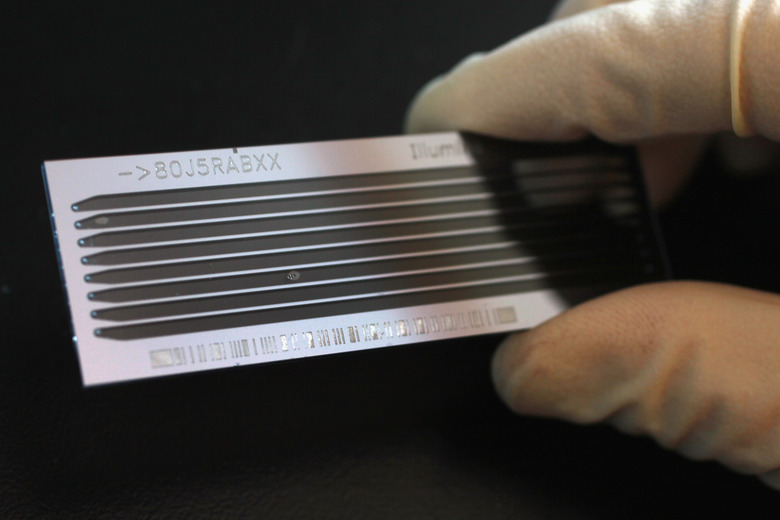What Does The DNA Nucleotide Sequence Code For?
It would be hard to get through grade school without hearing about how DNA is "the blueprint of life." It's in nearly every cell of nearly every living creature on Earth. DNA, deoxyribonucleic acid, contains all the information necessary to build a tree from a seed, two sibling bacteria from a single parent, and a human from a zygote. The details of how it guides these complex processes are connected to the nucleotide sequence in DNA — ordered in a three-segment code that defines how proteins are built. It does this in steps: the DNA builds RNA, then RNA builds proteins.
Bases in DNA
Bases in DNA
There is a lot of terminology associated with DNA, but learning a few important terms can help you understand the concepts. DNA is built from four different bases: adenine, guanine, thymine and cytosine, usually abbreviated as A, G, T and C. Sometimes people will refer to four different nucleosides or nucleotides in DNA, but those are just slightly different versions of the bases. The important thing is the sequence of A, G, T and C in a DNA strand, because it's the order of those bases that contains the code of DNA. DNA will usually be in a double stranded form, with two long molecules coiled around each other.
Creating RNA
Creating RNA
The ultimate purpose of DNA encoding is to create proteins, but DNA doesn't make proteins directly. Instead, it makes different types of RNA, which will then make the protein. RNA kind of looks like DNA — it has very similar structures, except that it almost always exists as a single strand instead of a double strand. The important thing is that RNA is built from the pattern that exists in the DNA with one difference: where DNA has a thymine, a "T," RNA has a uracil, a "U."
Protein Synthesis
Protein Synthesis
There are many different molecules involved in making proteins, but the basic work is done by two different kinds of RNA molecules. One is called mRNA, and it consists of long strands that contain the code for building a protein. The other is called tRNA. The tRNA molecule is much smaller, and it has one job: to carry amino acids to the mRNA molecule. The tRNA lines up on the mRNA according to the pattern of the bases on the mRNA — the order of the C, G, A and U segments. The tRNA only fits on the mRNA in one way, which means the amino acids carried by the tRNA will only line up in one way also. The order of those amino acids is what creates a protein.
Codons
Codons
There are four different bases in RNA. If each base matched with only one separate amino acid, then there could only be four different amino acids. But proteins are built from 20 amino acids. That works because each tRNA — the molecules that carry amino acids — matches up with a specific order of three bases on the mRNA. For example, if the mRNA has the three-base sequence CCU, then the only tRNA that will fit in that spot must carry the amino acid proline. These three-base sequences are called codons. The codons carry all the information necessary to make proteins.
Start and Stop Signs
Start and Stop Signs
DNA molecules are very long. A single DNA molecule can make many different RNA molecules, which then go make many different proteins. Part of the information on the long DNA molecules consists of signals or signposts to show where a strand of RNA should start and stop. So the DNA sequence contains two different types of information: the three-base codons that tell the RNA how to put amino acids together in a protein, and separate control signals that show where an RNA molecule should start and stop.
Cite This Article
MLA
Gaughan, Richard. "What Does The DNA Nucleotide Sequence Code For?" sciencing.com, https://www.sciencing.com/dna-nucleotide-sequence-code-for-3313/. 24 April 2017.
APA
Gaughan, Richard. (2017, April 24). What Does The DNA Nucleotide Sequence Code For?. sciencing.com. Retrieved from https://www.sciencing.com/dna-nucleotide-sequence-code-for-3313/
Chicago
Gaughan, Richard. What Does The DNA Nucleotide Sequence Code For? last modified March 24, 2022. https://www.sciencing.com/dna-nucleotide-sequence-code-for-3313/
